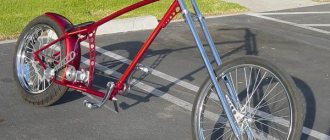A two-seater bicycle, or tandem, is ideal for leisurely family outings. Its principle is simple: both cyclists rotate the pedals, and control over turns and braking is exercised by the one sitting at the wheel, in front.
Tandem is interesting because it brings people together and forces them to be one indivisible system. Classic tandems are designed for smooth country roads, and this is justified: the longer the frame, the more difficult it is to drive over potholes, and the stronger the vibration and vertical loads, which ultimately lead to the destruction of the strongest structure.
Description
This unusual bicycle is driven by a person at the front, although there are also models with an installed steering switch mechanism. If the steering wheel does not perform a steering function, then it is used as a hand support. The braking system may also be engaged or disabled. There are models with two wheels on the rear axle.
From history: the first patented tandem bicycle appeared back in 1898 in Europe.
Reclining
A separate category of tricycles that are used as racing bicycles. This design allows you to ride in a reclining position or lying on your back.
The specific appearance attracts attention. This “adult” tricycle develops greater speed than standard models
Semi-recumbent bicycles are divided into:
– according to the intended purpose (sports, recreational and record racing);
– by the nature of the drive (with rear-wheel drive, with front-wheel drive and a movable carriage, with front-wheel drive and a fixed carriage);
– by wheelbase size (short, medium, long);
– according to the height of the seat above the ground: with high, medium (to the ground 40 cm) and low (15-20 cm) seating.
– semi-recumbent three-wheelers can be single or double (tandem).
Pros of use
- To cover the same distance on a tandem, the effort required is at least two times less than on a regular single bicycle.
- If one cyclist gets tired, then to rest it is enough to simply switch places, because the last passenger can ride with his eyes literally closed, and even put down his tired arms on flat sections of the route.
- The speed of a tandem bicycle is significantly higher than that of an ordinary cyclist. It can easily reach 35 kilometers per hour.
- The descent speed is also higher. Although the torque remains unchanged, the weight of the vehicle with passengers is at least twice as much.
- Emotional characteristics: team spirit, ability to work together, sense of community.
Types of trikes.
Semi-recumbent tricycle.
A semi-recumbent tricycle has pedals located at the front. It is an intermediate link between a regular and a recumbent tricycle. For some older people, a recumbent bike is not suitable due to the seating position, and they find it difficult to pedal on a standard tricycle. The semi-recumbent tricycle combines the best features of both types to provide a very comfortable ride.
Electric tricycle.
Be sure to consider an electric tricycle as a possible contender. On such a bicycle you can pedal whenever and as much as you want - when you don’t pedal, it still continues to move due to the motor-wheel.
Folding tricycle.
The folding tricycle is one of the newest bikes in the cycling world.
When choosing a tricycle, be sure to pay attention to folding models, which can help you save significant space in your apartment. You may not have been able to buy a trike before because it took up a lot of space, but now this disadvantage is a thing of the past.
Folding three-wheeled electric bicycle.
The folding electric tricycle has the advantages of a folding trike and an electric trike—not only is it easy to store, but also easy to ride. Ideal for older cyclists who often live in small apartments or houses. Now they no longer need to choose between a bicycle and, for example, a TV or a closet - such a bicycle will not take up much space.
Tricycle with a low frame.
A low frame trike may be the only solution for seniors who want to ride a bike but are unable to mount a regular trike.
Three-wheel tandem.
Riding a three-wheeled tandem will allow you to share the pleasure of the trip for two. On a regular tandem you can reach very high speeds and if you have problems maintaining balance, then it is not suitable for you. A three-wheeled tandem can be an alternative option, since maintaining balance on it is not difficult.
Three-wheeled chopper.
Three wheel choppers have added beauty to the world of tricycles. As a rule, all choppers have a stylish appearance that you will not find on ordinary two- or three-wheeled bicycles. If you want to stand out from the crowd in some way, then buy a three-wheeled chopper.
Double tricycle.
The two-seater tricycle is a unique way to travel together and still set the speed for two. In this case, it is not necessary for both cyclists to pedal at the same time - they can be pedaled one at a time. In addition, it is much easier to talk on such a bicycle than on a regular tandem, when the other cyclist sits with your back.
In fact, a two-seater "tricycle" has not three wheels, but four - the fourth wheel is needed to provide additional stability.
Recumbent tandem tricycle.
Recumbent three-wheel tandems have a variety of settings to ensure maximum comfort and pedaling efficiency, and a good seat to ensure a comfortable riding position. The 24-speed transmission makes it easy to climb and descend.
Let's get started
- An additional steering column bracket is added to the rear bike.
- In the front bike, you need to strengthen the trunk and install a cross-shaped tube (hinge) on it:
- We weld a support to the trunk.
- We screw a king pin to the welded support (you can make a king pin from an old front fork rod from a bicycle used for conversion).
- We put the hinge on the already screwed pin.
The advantage of such a semi-tandem is quick and easy assembly - the frames are not sawed, the chains on each bicycle remain separate. If necessary, such a tandem is very easy to divide again into two separate bicycles.
Advantages
With the help of a tandem, you can give the joy of riding to your children who are still unsure in the saddle of a solo bike or to friends who, for some reason, did not learn how to ride a bicycle in due time. If you have a long trip ahead in tandem , then this is a great opportunity to test the strength of a friendship or marriage, because only teamwork will lead you to the final destination. In addition, communication will become more convenient and pleasant than if you each left by personal transport.
Sharing the road between two or more people means spending half as much effort, which means traveling with special comfort. You can replace the helmsman if he is tired, you can regulate the speed and smoothness of turns through the coordinated work of all crew members.
The design of tandems is designed for heavy loads, so there is no doubt about their reliability. The powerful frame will support the strongest passengers, and the thick wheels with many spokes will serve for a long time without inflation.
And by purchasing a tandem, you will become a member of a small group of owners of a truly exclusive vehicle and will definitely attract the attention of passers-by in any city.
Metamorphosis of two broken bicycles
There is an option to make a tandem bicycle with your own hands, using two in a faulty condition, two sticks and one roll of electrical tape.
Tools and materials for work:
- Hacksaw for metal.
- Insulating tape.
- Adjustable wrench.
- Hammer.
- A tool that can be used to press out a chain or chain links connected together.
- Screwdriver.
- Any two bicycles that have a high top tube frame (usually found in men's models).
- The derailleur for the front gears should have the two smallest sprockets and the same number of teeth (it can be removed from an old bicycle if it fits the parameters, or you can purchase a new one on the market).
- Long cable for rear brake.
Order or production
A small plan for those who decided to make a 4-wheeled bike with their own hands.
- Let's start with the frame. We fully design it in a 3D editor or by hand, so that the manufacturers understand what and how to cut and weld. You should take into account the height of the rider, the required space, and the size of the wheels that you plan to use. Don’t forget about the mass and resistance of materials - the bike will be heavy, and the loads on it will be impressive.
- After the drawing, we go to the metalworking facility to make the frame. If you have the opportunity to do everything yourself, that’s great, but usually the finished drawing with explanations is given to a specialized company or a familiar craftsman.
- On the finished frame, all that remains is to assemble the chassis - first we mount the axle shafts for the wheels.
- Then we install the rear sprocket block, pedal assembly and tension the chain.
- We install the brake system.
- Install the steering column.
- We add a seat, steering wheel, grips and protection elements.
Of course, all the nuances can be learned only with practice, but the general “to-do list” will remain unchanged. We hope that making a bike with four wheels with your own hands will be successful.
Drawing of a simple velomobile
What's next?
To make a tandem bicycle (photos of examples are in our article), you need to do a few more operations. So:
- We are approaching the stage of chain extension. The front chain will have to be extended just enough to reach the rear wheel. The easiest way to do this is with a special chain squeezer. If such a special tool is not available, then purchase two links to connect in the chain and cut off the additional required length with a hacksaw. The entire chain should have no more than 37 links. Less is possible, but not more.
- In order for the frame of the assembled tandem bicycle to take the shape necessary for riding, it is enough, after the entire assembly, to put a load on it by twisting the chain on various sprockets.
- Let's synchronize the pedals with each other. This is necessary to avoid kicking each other while riding, as well as to maintain balance and pass the track on turns and hills.
- We attach the brake at the rear with a long cable.
- If desired, you can install a second steering wheel. However, it should be noted that this will interfere with maintaining balance.
Design
A standard tandem has a length of 230 cm or more, and weight reaches 20 kg. Its front sprocket usually has 60 teeth, and the rest - no more than 12, a chain 3 meters long is used (twice as long as usual), and the number of spokes in the wheels can reach up to 96. It has one frame and two wheels, like a regular one, but unlike him, each passenger has his own steering wheel, pedals and seat. There are models in which you can change the steering position, but this is a rather rare option.
A person who is not driving a tandem uses the steering wheel only as a support and to maintain balance.
If there are more than two crew members, you can develop a very decent speed.
Moreover, many details depend on the person sitting in front (“navigator”), since it is he who monitors the road, switches the speed mode and brakes. But the one who is in the tail (“stoker”) directly influences the movement of the entire vehicle: the more force he applies to the rotation of the pedals, the faster the bicycle overcomes obstacles. The remaining crew members (“aft crew”) must notify the driver about the situation on the road, report overtaking and monitor the cargo being transported.
And what kind of photographs will be taken by passengers who are not burdened with driving! On descents, such a bike has no equal, because traction is provided by gravity and the strength of several people at once. On the other hand, the more passengers, the more weight the structure has. Therefore, when braking, the brake pads experience increased load, which does not prolong their service life. The length affects maneuverability, which will make it difficult to navigate narrow and sharp turns.
Triple tandem
If there are three people in your family or company and everyone wants to ride one bicycle at once, then you will have to create a tandem tricycle with three seats. This option is perfect for a family with a child, for whom riding such a rare and unusual form of transport will be a truly unforgettable adventure. However, it is worth considering that maintaining balance on this model is much more difficult than on a single or double.
The working principle for making a 3-seat tandem bike with your own hands is the same as the two-wheel option mentioned above. But to create it you will need three original bicycles, where the third is attached to the second in the same way as the second is attached to the first.
With electric motor
An electric bicycle is another type of three-wheeler for adults. It differs from others in the presence of a small electric motor, which allows you to move without physical effort. A very attractive option for people with disabilities. Perhaps this is the most popular modification of an “adult” tricycle in European countries.
Ease of operation, safety and reliability, decent speed (up to 20 km/h), the ability to transport up to 100 kg of cargo - these are not all the advantages of an electric bicycle. It will not take up much storage space. Moreover, folding bicycle models with electric motors have also been developed.
The only concern will be charging the batteries. This can be done from a regular 220 V outlet. The batteries are completely sealed and packed in a special removable bag for convenient recharging. It is enough for 35-40 km. Lead batteries need to be changed once every 4 years, gel batteries can last up to 10 years.
The disadvantages of an electric bicycle include the rather large weight of the batteries. But recent developments with lithium batteries show that electric motors have a great future.
Electric tandem
Although it is easier to spin a tandem than a regular bicycle, it is worth the effort. After a couple of such trips, a dream appears that the pedals will spin by themselves. But is this really just a dream? If electric bicycles exist, is it really impossible to create a tandem electric bicycle? Let's see how you can do this yourself.
- A wheel-motor that simultaneously performs the functions of both a wheel and an electric motor. You just need to change the original one from a tandem to a new motor one.
- Rechargeable battery.
- The console, which is the control panel.
- Various wires and fasteners for the battery.
All this can be purchased individually or as a complete set. The manufacturing instructions are the same. The only difference is that you need to install an electric wheel on one of the bicycles. All you need is a couple of wrenches. That's it, the design will be suitable for use.
Source
Everything about a tandem bicycle and how to make it yourself
A tandem bicycle is a classic two-wheeled bicycle that has a number of characteristic features.
Two people can ride on such a device at the same time, and the second passenger can not only relax and enjoy the ride, but, together with his partner, take an active part in the movement.
Two-seater tandem bicycles are considered ideal sports and entertainment devices that are suitable for leisurely family outings.
The design of this bicycle is extremely simple; anyone can make with their own hands such a unit, the pedals of which can be rotated by both cyclists. Only the person sitting in front, behind the wheel, will control the cornering and brake the device.
A tandem bike will help you have fun
The main purpose of a tandem bicycle is to unite people. A shared ride forces cyclists to unite, to temporarily become a single indivisible mechanism that controls the system.
A standard tandem bicycle, as practice shows, can only be ridden on flat country road surfaces.
This feature is affected by the elongated frame, since when driving through holes and potholes, the unit is subjected to strong vibrations and significant vertical loads, which can, after a short period of time, lead to the destruction of the entire structure.
In the article below we will look at the advantages and disadvantages of a paired bicycle and provide step-by-step instructions for assembling the unit with your own hands.
Features of a duo bike
The tandem bicycle first saw the light of day in the 19th century; it is worth noting that a modernized version of the classic two-wheeled unit for one cyclist appeared almost immediately after the creation of the first single-seat standard design. It is noteworthy that as soon as the first pair bicycle was created, everyone who could afford it wanted to ride it. At that time, the tandem bicycle was tested by everyone, regardless of age, class and type of clothing.
However, over time, people began to look for more suitable donors, trying to convert not only the classic unit, but also other standard devices into a tandem bicycle, which led to the “doubling” of even such a model as the “penny farthing”.
Better known as the “spider,” a bicycle with one huge wheel and a second small one was reincarnated by eminent craftsmen in tandem, but this device was not very popular, which was most likely influenced by the “convenience” and “safety” of the design.
The tandem bicycle very quickly became a popular and sought-after design; it was even created for entire military units. It is reliably known from history that soldiers serving during the First World War moved in tandems of 8–10 people.
For the first time, Europeans developed a unit for so many cyclists, since they were the ones who could create a device that, even with such a huge load, could transport people on a flat surface.
Tandems eat up the brakes
Tandem braking is the most critical process and the hardest task to perform. A set of Cantilever or V-brake brakes - front and rear, which easily brake a single bicycle with a rider, will experience overloads in order to brake a 20-kilogram tandem with two cyclists weighing 60-80 kg each and, in addition, 20 kg of their luggage. Bicycle brakes become hot due to friction. Braking energy increases in proportion to the square of the speed. This means that at twice the speed of a single bicycle, the braking energy for a tandem increases by 8 times. Not 2 times! not 4, but 8 times! Since a tandem uses the same rims as a single seat bike, it makes it difficult to dissipate the increased heat flow. In short, don’t slow down over trifles, save the possibility of braking. The more you brake, the more heat you produce, which must be somehow removed from the rim. A bicycle wheel is not designed to withstand high heat, which can damage the tube (the wheel can “shoot”).
Tandems use different brakes: rim, disc, drum and hub. Three or more than three brakes are common on tandems. Manufacturers are very puzzled by how to effectively stop the moving mass of 160 -190 kg, which is carried by two cyclists on a equipped tandem.
Set yourself a loud signal and don't brake when you can avoid obstacles. And for long descents, come up with a more reasonable device than all these brakes, which do not slow down the main mass - tandem riders, but just a wheel rim or hub, from which the braking forces are transmitted to the main mass through thin spokes.
Maybe take the example of a musher who uses a stick to slow down the sled itself on the ground or snow, and not the hooves of the reindeer (-:))?
How to learn to ride?
Riding a tandem is the result of the united efforts of both participants. You must clearly know when to start, as well as when and where to brake - braking for a 180-kilogram system, due to inertia, is much more prolonged, and the braking distance will be longer here. Driving too fast or making a wrong turn can cause injury to both riders. If the tandem has several speeds, then the leader switches them.
Since the rear rider cannot see the road ahead, any pothole or bump will come as a surprise or even a shock to him. Consequently, the front rider must monitor the quality of the road - and avoid such obstacles - and not just steer and brake.
When changing speed, the leading cyclist warns the rear cyclist to ease the effort applied to the pedals for a few seconds. Ignoring this rule will lead to accelerated wear and premature failure of the speed switch.
When going uphill, keep your cadence high - another reason why it's important to work together when riding in tandem.
If you decide to travel some distance together, standing on the pedals, then it is advisable for both of you to stand up. A standing person does not have the opportunity to brake faster - especially when the bike is overloaded with bags, or both riders are too well-fed. This is true for both the lead and the stocker cyclist.
Terminology
The term tandem refers to the seating arrangement (front to back rather than side-by-side) rather than the number of riders. A bike with two riders side by side is called sociable.
Tandem bicycles are sometimes called "daisy bells". This is a reference to the popular song "Daisy Bell (A Bicycle Built for Two)", written in 1892 by British songwriter Harry Dacre, with the well-known chorus "Daisy, Daisy / Give me your answer, do it." / I'm half crazy / all for the love of you,” ending with “a bike for two.”
On conventional tandems, the front rider controls the bike in the same way as the pedals and is known as the captain
,
pilot
or
helmsman
;
the rear rider only pedals and is known as a stoker
,
navigator
, or
rear admiral
. On most tandems, the two sets of cranks are mechanically linked by a timing chain and rotate at the same speed.
History of creation
The first tandem bicycle appeared in Denmark in 1898. Engineers designed it for the military. It was assumed that when using a two-seater bicycle, two people would be able to defend themselves and repel the enemy. Their weight was about 11 kilograms.
At the beginning of the 20th century, low-quality steel began to be used. The tandems could not withstand the load and broke under the weight of the passengers.
It wasn't until 1963 that tandem bicycles began to be mass produced in the United States. They became available to ordinary citizens for transportation, as well as for entertainment.
Now many companies around the world offer their tandem bicycles for two or more passengers.
Manufacturers[edit]
Santana Beyond tandem with carbon fiber and titanium tubes and titanium lugs
Because the market for tandem bicycles is much smaller than the market for single bicycles, there are far fewer tandem bicycle manufacturers than there are single bicycle manufacturers. There are several manufacturers that specialize in tandems, as well as single bike manufacturers that offer tandem models. Current well-known tandem bicycle manufacturers include:
- Bike Friday
- Bilenkovsky bicycle factory
- Bohemian Bicycles
- Burley Design (now discontinued)
- Kalfi design
- Cannondale Bicycle Corporation
- Cycles of joint motion
- Cyfac International
- Dawes Cycles
- Gazelle
- Hase Spezialräder (Hase Bikes)
- Bicycles KHS
- Orbita bikes
- Santana Cycles
- Schwinn Bicycle Company
- Torker
- Trek Bicycles
Characteristic advantages of the model
Almost all the advantages that a tandem bicycle has have nothing to do with the specifics of cycling technology. Its main function is to develop a “sense of community” and to unite for a team trip. When multiple people must operate a single device in concert, they learn to make trade-offs. Among other technical features of the tandem it is worth noting:
- lack of fatigue. The fact is that for the same distance, walking on a tandem, a person will need to put in half as much effort. Pair control saves energy.
- high speed. A tandem bicycle can move almost twice as fast as a classic device for one cyclist, reaching speeds of up to 30–35 km/h.
- fast descent. When going down a hill or downhill, a tandem bicycle is able to reach higher speeds, despite the fact that the torque remains the same, the unit moves forward more strongly due to twice the weight.
- changing places of cyclists. If the person behind the wheel feels tired, he can change places with the second passenger. Sitting on the secondary seat, you can ride with your eyes closed or with your hands free.
The design feature of a tandem bicycle is such that the frame and wheels can withstand much greater static loads than a standard single-seat bicycle. This feature ensures the strength of the entire unit, which can last a very long time if the owner only rides on a flat road surface. A tandem bicycle has reinforced tires and tubes, more powerful rims, thicker spokes, a strong frame and an extended chain.
How to quickly learn to ride
Learning to ride a tandem bicycle is somewhat more difficult compared to the conventional version. Two people must act as synchronously as possible, and this skill is not achieved immediately. Riders pedal simultaneously. The one who sits in front switches gears and brakes in time, that is, in fact, completely controls the transport. In order to quickly master all the intricacies of traveling on this unusual bike, you must:
- Change places at the first sign of fatigue.
- At first, ride only on a flat road, preferably in a specially equipped bicycle zone in the city.
- People must trust each other to reach full agreement in all matters of bicycle control.
- Change speed promptly when there are any changes in terrain.
When a two-person bike is going uphill, the cadence should reach its maximum. Riding a standing tandem is not recommended. If this becomes necessary, both riders must synchronously assume a vertical position. In this case, it is forbidden to make sudden jerks while rotating the pedals.
The same goes for going uphill. To successfully overcome obstacles, riders riding a two-person bike will have to double their physical efforts.
At first glance, it seems that it is more difficult for the person driving in front, because he must watch the road, brake and change gears. However, it is also not easy for the second cyclist (stoker), since his view of the road is completely blocked. The recommended braking system for professionals is rim, for beginners it is drum or disc; the first makes the descent much easier, the second can quickly overheat with frequent use.
Since riding a tandem, especially for people unaccustomed to such a bicycle, requires a lot of physical effort, it is recommended to take breaks when any signs of fatigue appear. Otherwise, the pleasure of the trip will be spoiled, and two people may quarrel. A teenager as a lead rider can only ride on a busy road from the age of fourteen. The cyclist sitting in front requires attentiveness and good vision.
Choosing a high-quality tandem is not difficult; domestic and foreign manufacturers produce many models that differ in cost and technical characteristics. But it should be borne in mind that riding such a bicycle is a little more difficult than a regular one, so an inexperienced athlete can get seriously injured.
You need to pedal synchronously. The function of the person sitting in front is to control the bicycle and visually analyze the road
Varieties
The tandem can be two or three wheels. The second option is more stable, but is heavier and less maneuverable. Models with two electric motors, designed like a moped, are very popular. Such a bicycle can reach high speeds with minimal physical effort on the part of the riders.
The folding modification, or tandem transformer, is distinguished by maneuverability and compactness. This is a great option for children or teenagers. However, due to the small diameter of the wheels, this model is not recommended for travel on bad roads and rough terrain. This bike with two seats is convenient to ride in a city park or in the yard. When traveling outside the city, you can take it with you on public transport.
For experienced riders and athletes, an electric tandem is most suitable. It has two drives and a frame made of lightweight aluminum alloy. Typically a rim brake system is installed. This is the most expensive modification of a bicycle designed for two people. This type of transport allows you to reach speeds of up to 25 km/h. The standard wheel diameter is 28 inches, i.e. about 50 centimeters.
Options [edit]
More than two riders
Tandems can have more than two riders - tandem refers to the arrangement of riders behind each other, not the number of riders. Bicycles for three, four or five riders are called "triples" or "triples", "quadruples" or "quadruples" and "quints" or "quints" respectively. One such familiar sight to British television viewers was the "trandem" ridden by The Goodies. Originally a two-rider tandem with an additional dummy seat attached, a full three-rider version was built for them by Raleigh.
Best articles : Unicycles (unicycles)
An orchestra in Bruges, Belgium, uses a six-seater tandem bicycle, adapted to carry some instruments so that they can play music on the go. In the 80s or 90s, an eight-seat tandem bicycle was built and demonstrated in Philadelphia.
Independent pedaling
Some designs, such as the DaVinci, can allow independent pedaling by using multiple freewheels. In another design, the rear driver steers and drives the rear wheel using pedals, and the front driver drives the front wheel with both hands and feet.
Seating
Tandems come with both upright and reclining seats.
The "buddy bike" is designed to allow a child to sit on the front saddle and an adult to sit on the back seat, and is controlled using very long handlebars.
Dual steering
Both riders, if there are only two of them, can control. The Star Cycle Company of Wolverhampton, England introduced their "tandem combination roadsters" to the market in 1896. It had a connection from the second set of handlebars to the front fork. Others include Geneva 1897, and Stearns 1898.
Short wheelbase
There are short wheelbase models where the rear driver sits behind the rear wheel, either directly in front of the rear axle or even behind it.
Folding
Some manufacturers offer folding tandems with small or no wheels to make packing and transport easier.
Couplings
Couplings can be added either during production or as a retrofit so that the frame can be disassembled into smaller pieces for easier packaging and shipping. Santana makes a "triple" (or quad) that can be converted to a tandem by simply removing the center section of the frame."











